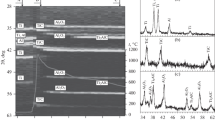Abstract
In order to investigate the microstructural evolution during self-propagating high-temperature synthesis (SHS) of Ti-Al powder mixture with an atomic ratio of Ti: Al=1:1, a combustion front quenching method (CFQM) was used for extinguishing the propagating combustion wave, and the microstructures on the quenched sample were observed with scanning electron microscope (SEM) and analyzed with energy dispersive spectrometry (EDS). In addition, the combustion temperature of the reaction was measured, and the phase constituent of the synthesized product was inspected by X-ray diffraction (XRD). The results showed that the combustion reaction started from melting of the Al particles, and the melting resulted in dissolving of the Ti particles and forming of Al3Ti grains. As the Al liquid was depleted, the combustion reaction proceeded through solid-state diffusion between the solid Al3Ti and the solid Ti. This led to the forming of TiAl and Ti3Al diffusing layers. In addition, the combustion reaction is incomplete besides TiAl, there are a large amount of Ti3Al and TiAl3 and a small amount of Ti in the final product. This incompleteness chiefly results from the using of coarser Ti powder.
Access this article
We’re sorry, something doesn't seem to be working properly.
Please try refreshing the page. If that doesn't work, please contact support so we can address the problem.
Similar content being viewed by others
References
N Bertolino, M Monagheddu, A Tacca, et al. Ignition Mechanism in Combustion Synthesis of Ti-Al and Ti-Ni Systems[J]. Intermetallics, 2003,11(1): 41–49
J Y Zhang, Z Y Fu, W M Wang, et al. Theoretical Study on Auto-oscillating Combustion in Self-propagating High Temperature Synthesis[J]. Journal of Wuhan University of Technology-Mater. Sci. Ed., 2003, 18(4): 32–34
Z A Munir, U Anselmi-Tamburini. Self-propagating Exothermic Reactions: The Synthesis of High-temperature Materials by Combustion[J]. Mater. Sci. Rep., 1989, 3:277–365
G Q Xiao, Q C Fan, M Z Gu, et al. Dissolution-precipitation Mechanism of Self-propagating High-temperature Synthesis of TiC-Ni Cermet[J]. Mater. Sci. Eng. A, 2004, 382:132–140
S H Lee, J H Lee, Y H Lee, et al. Effect of Heating Rate on the Combustion Synthesis of Intermetallics[J]. Mater. Sci. Eng. A, 2000, 281(1–2):275–285
S C Chen, Y H Chi, Y S Shi, et al. Ignition Time of Selfpropagating High-temperature Synthesis by Laser[J]. Trans. Nonferrous. Met. Soc. China, 2002, 12(1):49–53
Y L Yue, Y S Gong, H T Wu, et al. Fabrication and Mechanical Properties of TiC/TiAl Composites[J]. Journal of Wuhan University of Technology-Mater. Sci. Ed., 2004,19(1):1–4
W M Wang, M Xu, B C Mei. Investigation on Self-propagating High-temperature Synthesis of TiAl Intermetallic Compound[J]. Journal of Wuhan University of Technology-Mater. Sci. Ed., 1995, 10(3):1–5
C T Liu, J O Stiegler. Ductile Ordered Intermetallic Alloys[J]. Science, 1984, 226(4675):636–642
R Orru, G Cao, Z A Munir. Mechanistic Investigation of the Field-activated Combustion Synthesis (FACS) of Titanium Aluminides[J]. Chemical Engineering Science,1999,54(15–16): 3 349–3 355
T W Lee, C H Lee. The Effect of Heating Rate on the Reactive Sintering of Ti-48%Al Elemental Powder Mixture[J]. Journal of Materials Science Letters, 1998,17(16):1 367–1 370
Y Q Su, G Z Liu, J J Peng, et al. Melting Throughout Time and Energy Consumption for TiAl Alloys During ISM Process[J]. Trans. Nonferrous. Met. Soc. China, 2005, 15(1):1–6
X J Wang, Q C Fan, T D Xia, et al. Mechanism of Self-propagating High-temperature of TiAl[J]. Journal of Gansu University of Technology, 2003, 29(3): 22–24
X C Wang, X M Zhang, H F Chai, et al. End-quenching and Extinguishing Analysis of Microstructural Evolution Kinetics in the TiAl Alloy Synthesized by Combustion[J]. Rare Metal Materials and Engineering, 1999,28(3):161–165
X Xiong, B Y Huang. Study of Self-propagating High Temperature Synthesis[J]. Powder Metallurgy Technology, 1994,12(2):83–86
Q C Fan, H F Chai, Z H Jin. Dissolution-precipitation-substitution Mechanism of Self-propagating High-temperature Synthesis of β-NiAl (Cu) / α(Cu,Ni) Composite[J]. Intermetallic, 2002,10(6):541–
Y J Wu, T Lan. Study on Infiltration Combustion Synthesis (ICS) of TiAl Intermetallic Compound[J]. Rare Metal Materials and Engineering, 1996, 25(2):17–20
Author information
Authors and Affiliations
Corresponding author
Rights and permissions
About this article
Cite this article
Ma, Y., Fan, Q., Zhang, J. et al. Microstructural evolution during self-propagating high-temperature synthesis of Ti-Al system. J. Wuhan Univ. Technol.-Mat. Sci. Edit. 23, 381–385 (2008). https://doi.org/10.1007/s11595-007-3281-6
Received:
Accepted:
Published:
Issue Date:
DOI: https://doi.org/10.1007/s11595-007-3281-6



